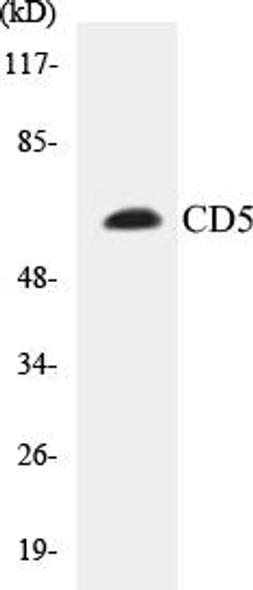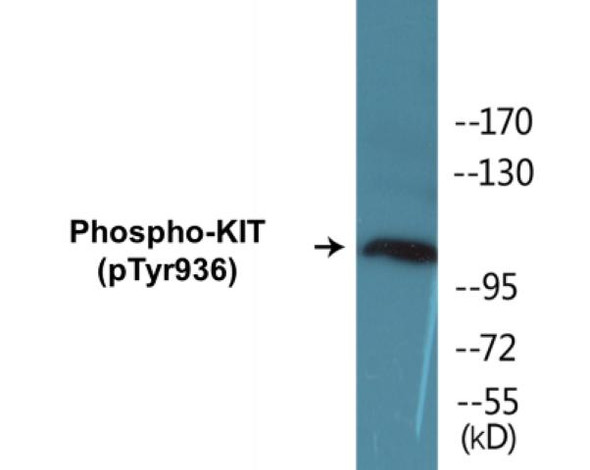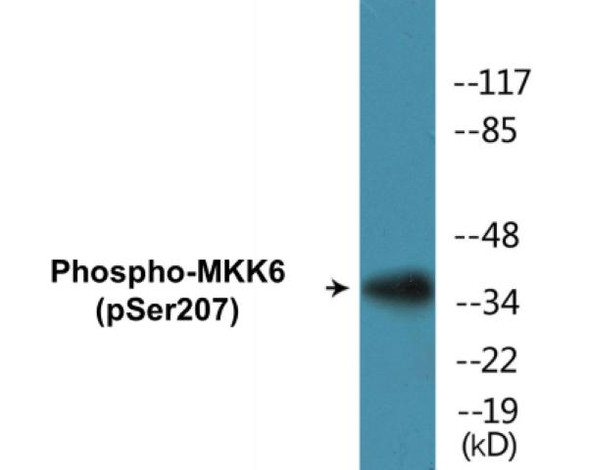CD5 (Phospho-Tyr453)Colorimetric Cell-Based ELISA Kit (CBCAB00442)
- SKU:
- CBCAB00442
- Product Type:
- ELISA Kit
- ELISA Type:
- Cell Based Phospho Specific
- Reactivity:
- Human
- Mouse
- Rat
- Detection Method:
- Colorimetric
Description
CD5 (Phospho-Tyr453)Colorimetric Cell-Based ELISA Kit
The CD5 Phospho-Tyr453 Colorimetric Cell-Based ELISA Kit is a powerful tool for studying the phosphorylation status of CD5 protein in cell samples. This kit is specifically designed for the accurate and sensitive detection of CD5 phosphorylated at tyrosine 453 in various cell lysates, providing researchers with valuable insights into signaling pathways and cellular processes.CD5 is a cell surface glycoprotein that plays a critical role in T cell development and activation, making it a key target for studying immune responses and autoimmune diseases. Phosphorylation of CD5 at tyrosine 453 has been shown to regulate its function and signaling activities, making it an important marker for investigating immune cell signaling pathways.
With its high sensitivity and specificity, the CD5 Phospho-Tyr453 Colorimetric Cell-Based ELISA Kit offers reliable and reproducible results, allowing researchers to confidently analyze CD5 phosphorylation levels and their impact on cellular functions. This kit is an essential tool for researchers studying immune signaling pathways, T cell biology, and autoimmune diseases.
| Product Name: | CD5 (Phospho-Tyr453)Colorimetric Cell-Based ELISA Kit |
| Product Code: | CBCAB00442 |
| ELISA Type: | Cell-Based |
| Target: | CD5 (Phospho-Tyr453) |
| Reactivity: | Human, Mouse, Rat |
| Dynamic Range: | > 5000 Cells |
| Detection Method: | Colorimetric 450 nm |
| Format: | 2 x 96-Well Microplates |
The CD5 (Phospho-Tyr453) Colorimetric Cell-Based ELISA Kit is a convenient, lysate-free, high throughput and sensitive assay kit that can detect CD5 protein phosphorylation and expression profile in cells. The kit can be used for measuring the relative amounts of phosphorylated CD5 in cultured cells as well as screening for the effects that various treatments, inhibitors (ie. siRNA or chemicals), or activators have on CD5 phosphorylation.
Qualitative determination of CD5 (Phospho-Tyr453) concentration is achieved by an indirect ELISA format. In essence, CD5 (Phospho-Tyr453) is captured by CD5 (Phospho-Tyr453)-specific primary antibodies while the HRP-conjugated secondary antibodies bind the Fc region of the primary antibody. Through this binding, the HRP enzyme conjugated to the secondary antibody can catalyze a colorimetric reaction upon substrate addition. Due to the qualitative nature of the Cell-Based ELISA, multiple normalization methods are needed:
| 1. | A monoclonal antibody specific for human GAPDH is included to serve as an internal positive control in normalizing the target absorbance values. |
| 2. | Following the colorimetric measurement of HRP activity via substrate addition, the Crystal Violet whole-cell staining method may be used to determine cell density. After staining, the results can be analysed by normalizing the absorbance values to cell amounts, by which the plating difference can be adjusted. |
| Database Information: | Gene ID: 921, UniProt ID: P06127, OMIM: 153340, Unigene: Hs.58685 |
| Gene Symbol: | CD5 |
| Sub Type: | Phospho |
| UniProt Protein Function: | CD5: a surface glycoprotein expressed on T cells and B-1 B cells. Rapidly recruited to the immunological synapse, lowering the response of the T cell antigen receptor. CD5 interacts with CD72/LYB-2. Promotes B-cell survival through stimulation of autocrine IL-10 production. Contains 3 SRCR domains. |
| UniProt Protein Details: | Protein type:Cell surface; Membrane protein, integral Chromosomal Location of Human Ortholog: 11q13 Cellular Component: integral to plasma membrane; plasma membrane; external side of plasma membrane Molecular Function:protein binding; transmembrane receptor activity; receptor activity; scavenger receptor activity Biological Process: cell proliferation; receptor-mediated endocytosis; T cell costimulation; cell recognition |
| UniProt Code: | P06127 |
| NCBI GenInfo Identifier: | 313104090 |
| NCBI Gene ID: | 921 |
| NCBI Accession: | P06127.2 |
| UniProt Secondary Accession: | P06127,A0N0P4, A8K9I3, |
| UniProt Related Accession: | P06127 |
| Molecular Weight: | 459 |
| NCBI Full Name: | T-cell surface glycoprotein CD5 |
| NCBI Synonym Full Names: | CD5 molecule |
| NCBI Official Symbol: | CD5 |
| NCBI Official Synonym Symbols: | T1; LEU1 |
| NCBI Protein Information: | T-cell surface glycoprotein CD5; CD5 antigen (p56-62); lymphocyte antigen T1/Leu-1 |
| UniProt Protein Name: | T-cell surface glycoprotein CD5 |
| UniProt Synonym Protein Names: | Lymphocyte antigen T1/Leu-1; CD_antigen: CD5 |
| Protein Family: | CD5 antigen |
| UniProt Gene Name: | CD5 |
| UniProt Entry Name: | CD5_HUMAN |
| Component | Quantity |
| 96-Well Cell Culture Clear-Bottom Microplate | 2 plates |
| 10X TBS | 24 mL |
| Quenching Buffer | 24 mL |
| Blocking Buffer | 50 mL |
| 15X Wash Buffer | 50 mL |
| Primary Antibody Diluent | 12 mL |
| 100x Anti-Phospho Target Antibody | 60 µL |
| 100x Anti-Target Antibody | 60 µL |
| Anti-GAPDH Antibody | 60 µL |
| HRP-Conjugated Anti-Rabbit IgG Antibody | 12 mL |
| HRP-Conjugated Anti-Mouse IgG Antibody | 12 mL |
| SDS Solution | 12 mL |
| Stop Solution | 24 mL |
| Ready-to-Use Substrate | 12 mL |
| Crystal Violet Solution | 12 mL |
| Adhesive Plate Seals | 2 seals |
The following materials and/or equipment are NOT provided in this kit but are necessary to successfully conduct the experiment:
- Microplate reader able to measure absorbance at 450 nm and/or 595 nm for Crystal Violet Cell Staining (Optional)
- Micropipettes with capability of measuring volumes ranging from 1 µL to 1 ml
- 37% formaldehyde (Sigma Cat# F-8775) or formaldehyde from other sources
- Squirt bottle, manifold dispenser, multichannel pipette reservoir or automated microplate washer
- Graph paper or computer software capable of generating or displaying logarithmic functions
- Absorbent papers or vacuum aspirator
- Test tubes or microfuge tubes capable of storing ≥1 ml
- Poly-L-Lysine (Sigma Cat# P4832 for suspension cells)
- Orbital shaker (optional)
- Deionized or sterile water
*Note: Protocols are specific to each batch/lot. For the correct instructions please follow the protocol included in your kit.
| Step | Procedure |
| 1. | Seed 200 µL of 20,000 adherent cells in culture medium in each well of a 96-well plate. The plates included in the kit are sterile and treated for cell culture. For suspension cells and loosely attached cells, coat the plates with 100 µL of 10 µg/ml Poly-L-Lysine (not included) to each well of a 96-well plate for 30 minutes at 37°C prior to adding cells. |
| 2. | Incubate the cells for overnight at 37°C, 5% CO2. |
| 3. | Treat the cells as desired. |
| 4. | Remove the cell culture medium and rinse with 200 µL of 1x TBS, twice. |
| 5. | Fix the cells by incubating with 100 µL of Fixing Solution for 20 minutes at room temperature. The 4% formaldehyde is used for adherent cells and 8% formaldehyde is used for suspension cells and loosely attached cells. |
| 6. | Remove the Fixing Solution and wash the plate 3 times with 200 µL 1x Wash Buffer for five minutes each time with gentle shaking on the orbital shaker. The plate can be stored at 4°C for a week. |
| 7. | Add 100 µL of Quenching Buffer and incubate for 20 minutes at room temperature. |
| 8. | Wash the plate 3 times with 1x Wash Buffer for 5 minutes each time. |
| 9. | Add 200 µL of Blocking Buffer and incubate for 1 hour at room temperature. |
| 10. | Wash 3 times with 200 µL of 1x Wash Buffer for 5 minutes each time. |
| 11. | Add 50 µL of 1x primary antibodies Anti-CD5 (Phospho-Tyr453) Antibody, Anti-CD5 Antibody and/or Anti-GAPDH Antibody) to the corresponding wells, cover with Parafilm and incubate for 16 hours (overnight) at 4°C. If the target expression is known to be high, incubate for 2 hours at room temperature. |
| 12. | Wash 3 times with 200 µL of 1x Wash Buffer for 5 minutes each time. |
| 13. | Add 50 µL of 1x secondary antibodies (HRP-Conjugated AntiRabbit IgG Antibody or HRP-Conjugated Anti-Mouse IgG Antibody) to corresponding wells and incubate for 1.5 hours at room temperature. |
| 14. | Wash 3 times with 200 µL of 1x Wash Buffer for 5 minutes each time. |
| 15. | Add 50 µL of Ready-to-Use Substrate to each well and incubate for 30 minutes at room temperature in the dark. |
| 16. | Add 50 µL of Stop Solution to each well and read OD at 450 nm immediately using the microplate reader. |
(Additional Crystal Violet staining may be performed if desired – details of this may be found in the kit technical manual.)






